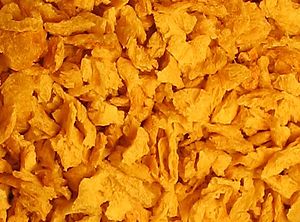Textured vegetable protein facts for kids

Textured vegetable protein (TVP), also known as textured soy protein (TSP) or soy meat, is a food made from soybeans after most of their oil has been removed. It is often used as a meat substitute or to make meat dishes bigger. TVP cooks quickly and has a lot of protein, similar to some meats.
TVP can be made from other protein-rich seeds too, not just soybeans. These include lentils, peas, and faba beans. In China, TVP is even made from peanuts because peanut oil is a popular cooking oil there.
Contents
The Story of TVP
Textured vegetable protein was first created by a company called Archer Daniels Midland in the 1960s. This company even owns the name "textured vegetable protein" as a special trademark.
At first, the company made TVP in the shape of rods or tubes. They tried selling it to be used in chili powder, but it wasn't very popular. However, by 1968, TVP was being used in many different foods. Its use really grew after 1971, when it was allowed in school lunch programs. By 1980, other companies started making similar products, but Archer Daniels Midland remained the top producer of TVP.
How TVP Is Made
TVP is usually made from soy flour or soy concentrate, which are high in protein. It can also be made from other plants like cottonseed, wheat, and oats.
The process involves pushing the defatted protein through a special machine called an extruder. This machine shapes the protein into different forms like chunks, flakes, or strips. As the hot, squishy protein comes out of the machine, it expands and becomes a puffy, solid material. This material is then dried.
When dry, TVP is about 50% protein. It can soak up a lot of liquid, up to three times its own weight. When you add water to it, the protein content becomes similar to that of ground meat, around 16%. TVP is often used instead of meat because it costs much less than ground beef. When cooked with meat, TVP can also help the dish keep more of its nutrients by soaking up juices that might otherwise be lost.
Some companies use a chemical called hexane to separate the fat from the soy protein. Very tiny amounts of hexane might be left in the TVP. However, studies have shown that you would need to eat a huge amount of TVP to get enough hexane to cause any harm.
What TVP Is Like
| Nutritional value per 100 g (3.5 oz) | |
|---|---|
| Energy | 1,392 kJ (333 kcal) |
|
33.9 g
|
|
| Sugars | 16.4 g |
| Dietary fiber | 17.5 g |
|
1.2 g
|
|
|
Protein
|
51.5 g
|
| Vitamins | Quantity
%DV†
|
| Thiamine (B1) |
61%
0.7 mg |
| Riboflavin (B2) |
21%
0.253 mg |
| Niacin (B3) |
16%
2.612 mg |
| Vitamin B6 |
44%
0.574 mg |
| Folate (B9) |
76%
305 μg |
| Vitamin C |
0%
0 mg |
| Minerals | Quantity
%DV†
|
| Calcium |
24%
241 mg |
| Iron |
71%
9.2 mg |
| Magnesium |
82%
290 mg |
| Phosphorus |
96%
674 mg |
| Potassium |
79%
2384 mg |
| Selenium |
2%
1.7 μg |
| Sodium |
1%
20 mg |
| Zinc |
26%
2.5 mg |
| Other constituents | Quantity |
| Water | 7.25 g |
|
Link to USDA Database entry
|
|
| †Percentages estimated using US recommendations for adults. | |
TVP can be made from soy flour (50% protein) or soy concentrate (70% protein). Both have a mild, slightly "beany" taste. Before you can use TVP, you need to add water to it. Sometimes, people add flavorings at the same time.
The way TVP is made changes the soy protein, making it into a spongy, fiber-like material. This gives it a texture similar to meat. When TVP is dry, it can last for more than a year on the shelf. But once you add water to it, it will spoil within a few days. TVP flakes can be used in many ways, just like ground meat.
TVP and Your Health
When dry, textured vegetable protein is mostly protein (about 52%), carbohydrates (about 34%), and a small amount of fat (about 1%). It also contains about 7% water.
A 100-gram serving of dry TVP provides about 327 calories. It is a great source of many important nutrients. These include several B vitamins, especially folate. It's also rich in dietary minerals like phosphorus, magnesium, and iron.
How TVP Is Used
Textured vegetable protein is a very flexible food. Its different shapes allow it to take on the texture of whatever ground meat it is replacing. You can use TVP to make vegetarian or vegan versions of dishes that usually have meat. For example, you can make meat-free chili, spaghetti bolognese, sloppy joes, tacos, burgers, or burritos.
Soy protein is also used to make meat and poultry products bigger and more affordable. It's often found in foods served in schools and prisons. Using TVP can lower the fat and cholesterol in a dish. When TVP is used by itself as a meat substitute, it has no fat at all. It can be seasoned well to taste like red meat.
You can find textured vegetable protein in health food stores and larger supermarkets, often in the bulk food section. TVP is also very light, so it's a popular ingredient for backpacking meals. Because it's cheap, high in protein, and lasts a long time, TVP is often used for disaster preparedness. However, people with a soy allergy should not eat TVP.
See also
 In Spanish: Carne de soya para niños
In Spanish: Carne de soya para niños


